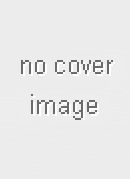Two daughter molecules of DNA are the product of which process?
Multiple choice question.
Reverse transcription
Transcription
Translation
DNA replication
Transduction
DNA replication
How many strands of DNA are there in a double helix?
Multiple choice question.
4
2
3
1
2
What are the individual building blocks of a strand of DNA called?
Multiple choice question.
Bases
Amino acids
Nucleotides
Riboses
Nucleotides
The names of the bases found in DNA nucleotides are: ____, ____, ____, and ____.
adenine or a
cytosine or c
thymine or t
guanine or g
The two strands of DNA in a double helix associate with one another due to ____ bonding between opposite bases in the helix and due to the nucleotides stacking on top of one another to form a ladder-like structure.
hydrogen
Parental DNA strands are used as templates to produce daughter DNA strands during the process called ____ ____.
DNA replication
When two strands of DNA associate to form a double helix, the bases on opposite strands of DNA interact via hydrogen bonds. Different numbers of hydrogen bonds form between the different base-pairs: there are ____ hydrogen bonds between adenine and ____, and between cytosine and ____ there are ____ hydrogen bonds.
2; thymine; guanine; 3
In the DNA double helix, there are ____ strands of DNA.
2 or double
Select all that apply
Which of the following are analogous to the antiparallel arrangement of strands of DNA in a double helix?
Multiple select question.
Two pencils laid next to one another pointing in opposite directions
A single set of train tracks
Two pencils laid end to end (eraser to tip, eraser to tip)
A two lane, two way highway with a divider/median
Two pencils laid next to one another pointing in opposite directions
A two lane, two way highway with a divider/median
Individual strands of DNA are composed of building blocks called
nucleotides
In a DNA double helix, one strand of DNA runs 5' to 3' and the other strand runs 3' to 5'. Because the two strands are arranged like this and never cross one another, the two strands are said to be
antiparallel
Select all that apply
What are the types of bases found in DNA?
Multiple select question.
Thymine
Cytosine
Guanine
Adenine
Ribose
Uracil
Deoxyribose
Thymine
Cytosine
Guanine
Adenine
Select all that apply
How are the two strands of DNA held together in a double helix?
Multiple select question.
Ionic bonds between opposite bases
Stacking of the bases on top of one another
Phosphodiester bonds between opposite bases
Hydrogen bonds between opposite bases
Stacking of the bases on top of one another
Hydrogen bonds between opposite bases
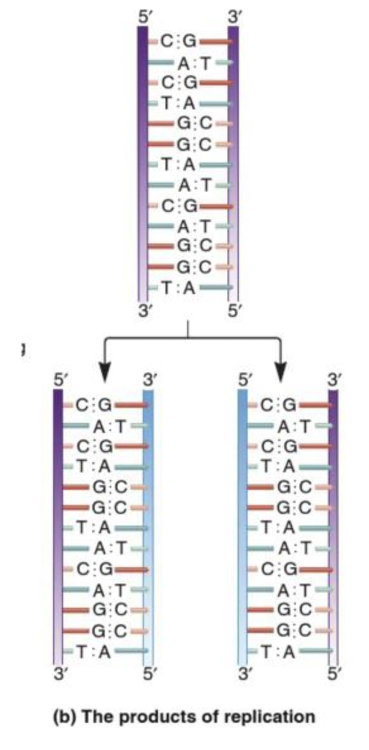
What is the name given to the strand of DNA that contains the information to make the new strand of DNA during DNA replication?
Multiple choice question.
The conserved strand
The template strand
The complementary strand
The daughter strand
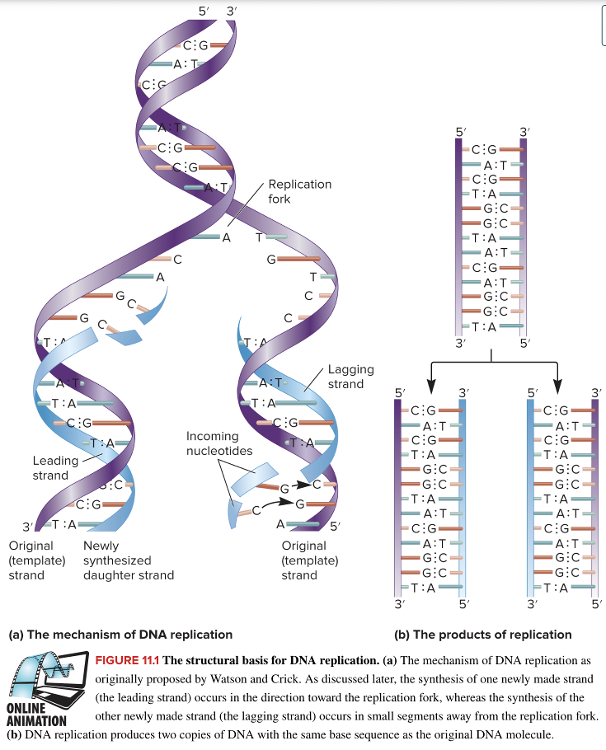
The template strand
Select all that apply
Which of the following demonstrate correct base pairing?
Multiple select question.
C - G with 2 hydrogen bonds
A - T with 2 hydrogen bonds
C - G with 3 hydrogen bonds
A - T with 3 hydrogen bonds
A - T with 2 hydrogen bonds
C - G with 3 hydrogen bonds

What is the name of the new strand of DNA that is produced during DNA replication?
Multiple choice question.
The coding strand
The daughter strand
The template strand
The parental strand

The daughter strand
Escalators usually come in pairs; one moves people upwards between floors and one moves people downward between floors. Given that one goes in one direction and the other goes in the other direction, and they don't cross over one another, this is an example of something that is ______.
Multiple choice question.
antiparallel
confluent
redundant
parallel
complimentary
antiparallel
Match the three proposed models of DNA replication with the correct description.
Dispersive
Conservative
Semiconservative
The daughter molecules of DNA consist of one strand of parental DNA and one complementary strand of newly formed DNA.
Both strands of parental DNA remain together following replication and the daughter molecule consists of only newly synthesized DNA strands.
Pieces of parental DNA and newly synthesized DNA are interspersed throughout both daughter strands in the newly formed molecule.
- Dispersive Pieces of parental DNA and newly synthesized DNA are interspersed throughout both daughter strands in the newly formed molecule.
- Conservative Both strands of parental DNA remain together following replication and the daughter molecule consists of only newly synthesized DNA strands.
- Semiconservative
The daughter molecules of DNA consist of one strand of parental DNA and one complementary strand of newly formed DNA.
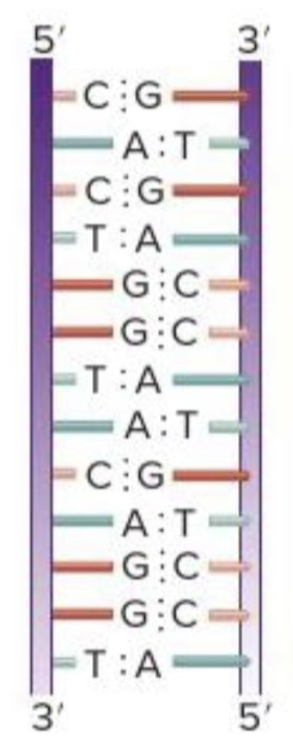
As shown in the figure, the two strands of the DNA double helix run in opposite directions: one runs 5' to 3' and the other runs 3' to 5'. Also, the two strands never cross one another. This arrangement of the two strands of DNA in a double helix as described as

antiparallel
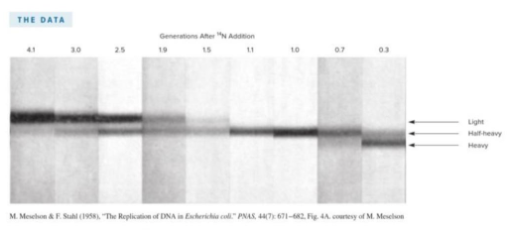
In the Meselson and Stahl experiment, E.coli was first grown in medium containing 15N compounds such that all N in the DNA contained 15N. The cells were then grown in medium containing 14N for various periods of time. The bacterial lysate was then separated by CsCl centrifugation. The experiment yielded the data in the image shown. This experiment suggested that DNA replication is
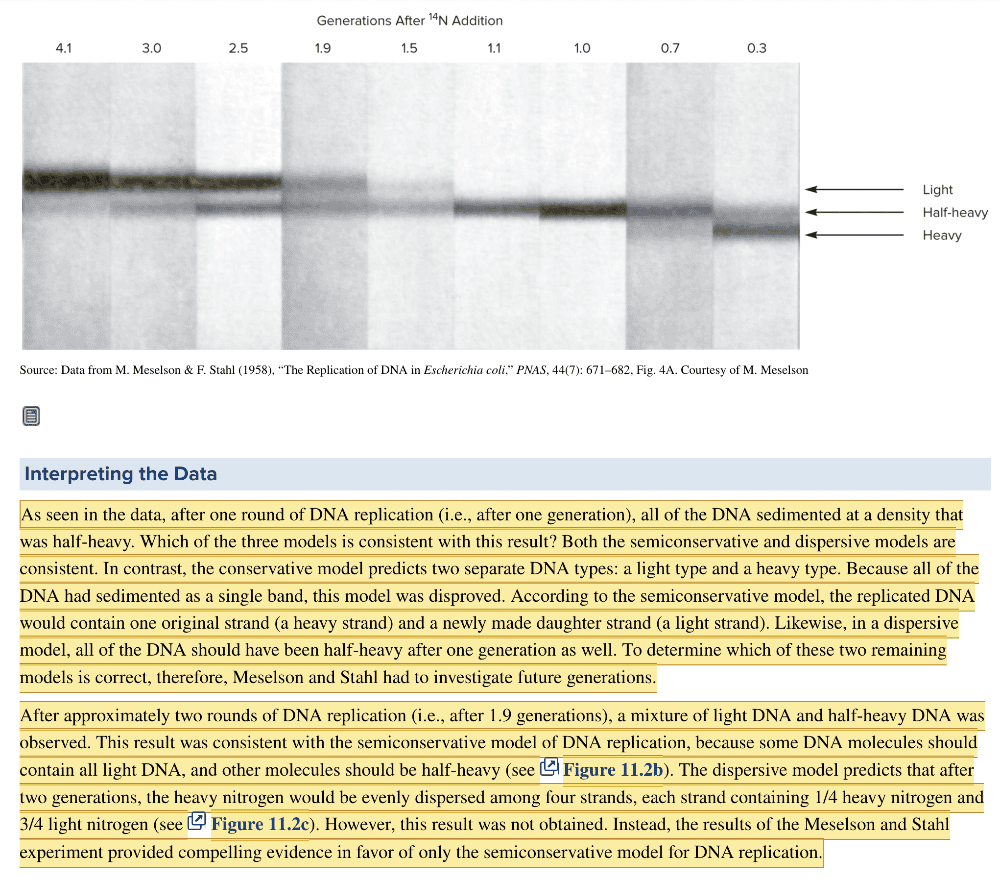
semiconservative
The figure shows data from Meselson and Stahl's experiment to determine the mechanism of DNA replication. After one generation, which model(s) for DNA replication does the data support?
Multiple choice question.
Only the dispersive model
Both semiconservative and dispersive models
Only the conservative model
Only the semiconservative model
Both semiconservative and conservative models
Both conservative and dispersive models
Both semiconservative and dispersive models

The strand of DNA that contains the information used to make a new strand of DNA during DNA replication is called the ____ strand.

template
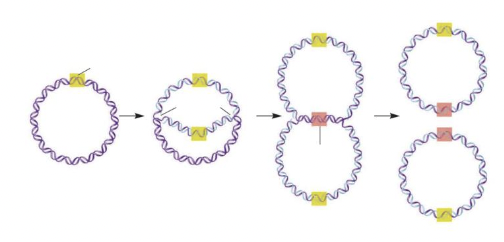
The area highlighted in yellow, where DNA replication begins, is called the ____ ____ ____.
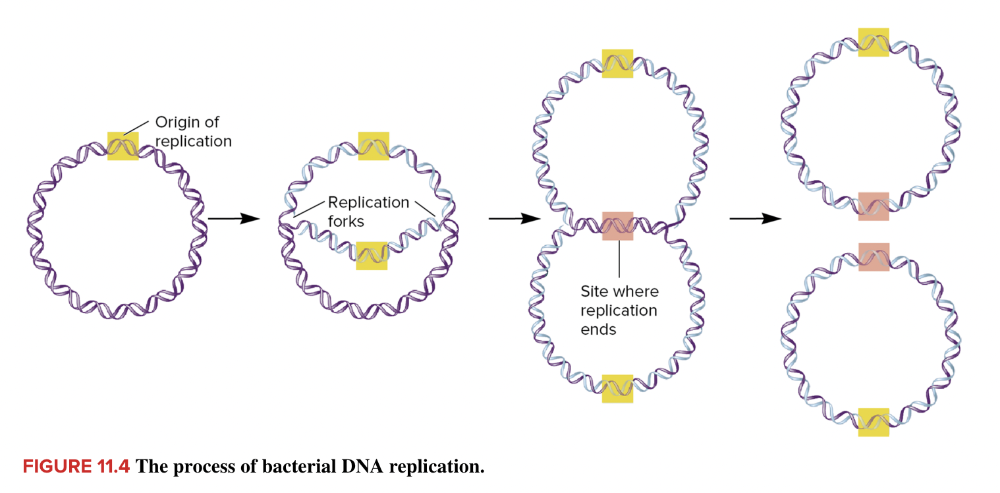
origin of replication

The strand of DNA that is produced during DNA replication is generally called the ____ strand.

daughter
Because DNA replication proceeds in both directions from a single origin of replication, it is said to be ____ replication.
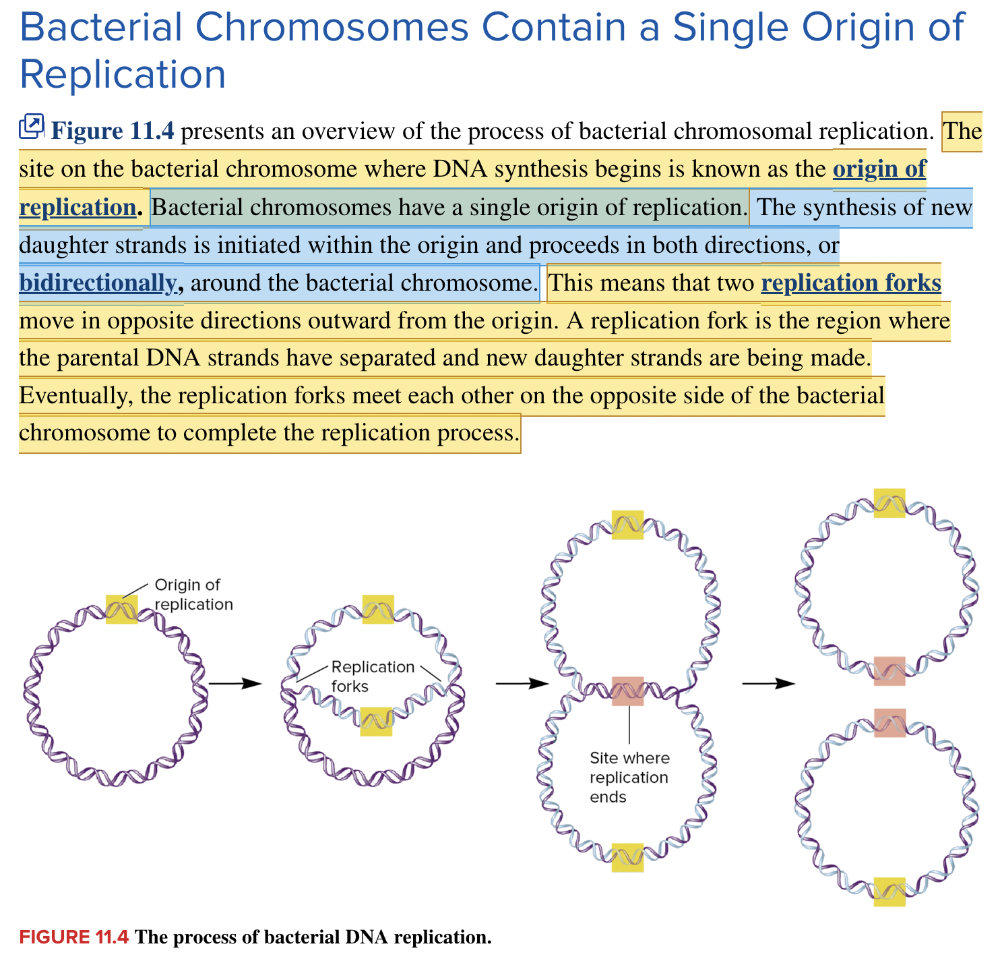
bidirectional
Match the three proposed types of replication with the correct figure.
Instructions
A
B
C
Semiconservative model
Dispersive model
Conservative model
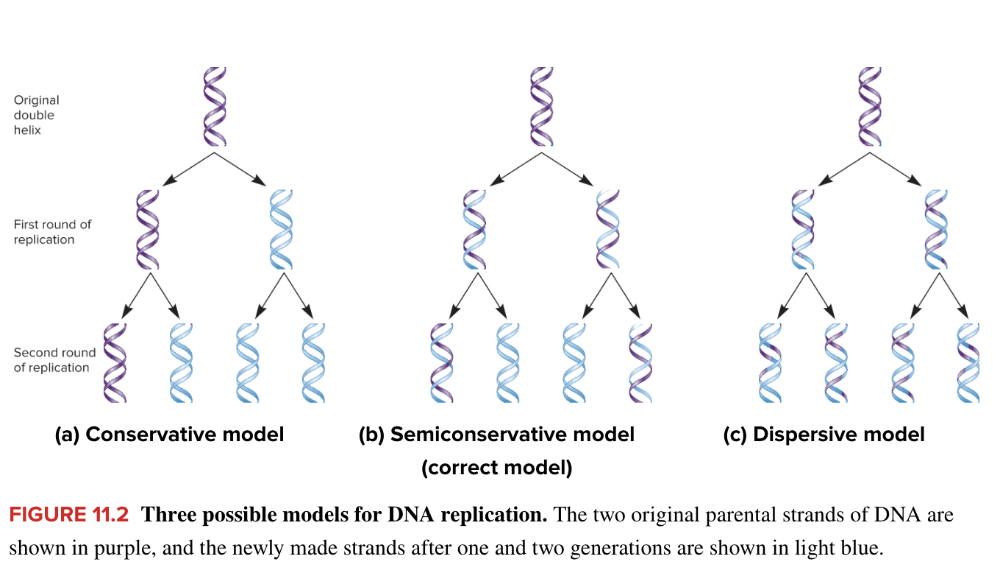
- A Conservative model
- B Semiconservative model
- C Dispersive model
The sites where the parental template strands of DNA separate during replication are called the ____ ____.
replication fork
List the steps of Meselson and Stahl's experiment, which provided evidence of semiconservative DNA replication, in the correct sequence.
Lyse the cells and separate the lysate in a CsCl gradient.
Add 14N to the growth medium and incubate for various lengths of time such that all newly formed DNA will contain 14N.
Grow E. coli in the presence of 15N for many generations such that all of the N in the DNA is labeled with 15N.
Centrifuge the gradients such that all DNA molecules reach their equilibrium densities.
Observe the DNA under UV light.
1) Grow E.coli in the presence of 15N for many generations such that
all of the N in the DNA is labeled with 15N.
2) Add 14N to the
growth medium and incubate for various lengths of time such that all
newly formed DNA will contain 14N.
3) Lyse the cells and separate
the lysate in a CsCl gradient.
4) Centrifuge the gradients such
that all DNA molecules reach their equilibrium densities.
5)
Observe the DNA under UV light.

The figure shows data from Meselson and Stahl's experiment to determine the mechanism of DNA replication. After 1.9 generations, which model(s) for DNA replication does the data support?
Multiple choice question.
Both the conservative and dispersive models
Only the conservative model
Only the dispersive model
Only the semiconservative model
Both the semiconservative and dispersive models
Only the semiconservative model
DNA replication begins at a site called the ____ of ____.
origin of replication
The three types of DNA sequences located within the oriC complex are the ____ rich region, ____ box sequence and the ____ methylation site.
AT
DNAa
GATC
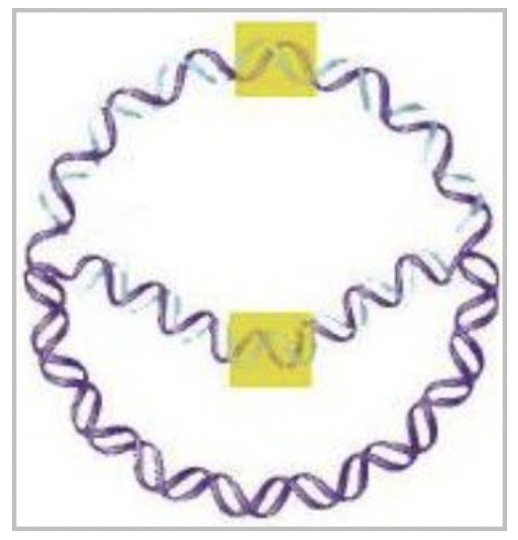
As shown in the image, bacterial DNA replication occurs ____ from a single origin of replication.

bidirectionally
For E. coli, what occurs prior to helicase binding and creating two replication forks?
Multiple choice question.
DnaA proteins bind to sequences in the five DnaA boxes
Initiation factors bind to the promoter
mRNA binds to the ribosome
DNA polymerase binds to the template strand
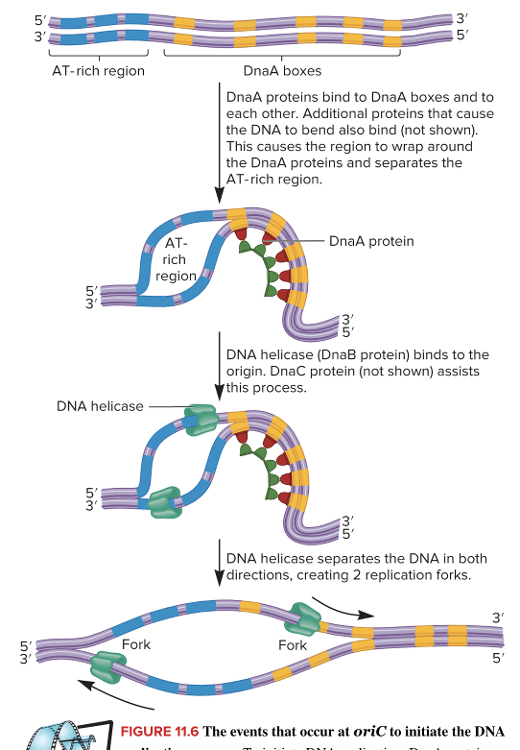
DnaA proteins bind to sequences in the five DnaA boxes
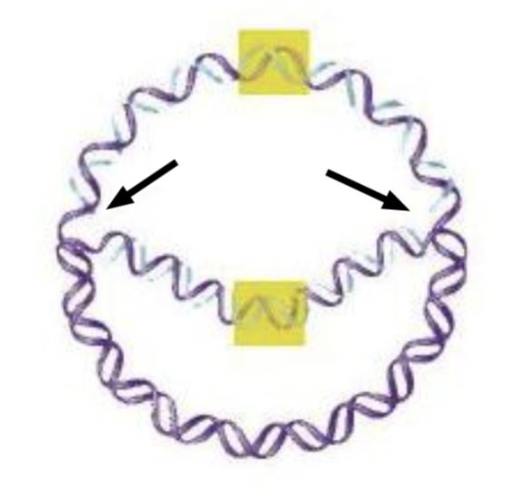
The areas at the tips of the arrows in this replicating molecule of DNA are called the ____ ____.

replication forks
DNA helicase ______.
Multiple choice question.
joins two Okasaki fragments together
separates double-stranded DNA into two single strands
removes positive supercoils that accumulate ahead of the replication fork
creates negative supercoils in DNA molecules
separates double-stranded DNA into two single strands
The name of the enzyme that methylates the GATC methylation site within the oriC is
DAM
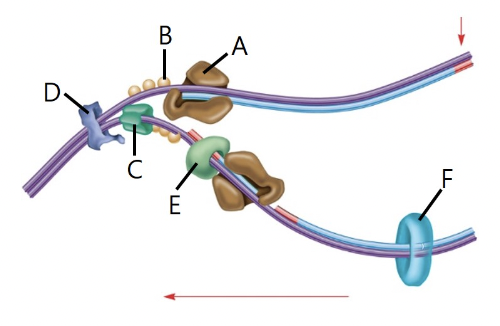
Identify the proteins shown in the image that are involved in E. coli DNA replication.
A
B
C
D
E
F
DNA ligase
DNA polymerase III
Topoisomerase II
Single stranded binding protein
Primase
DNA helicase
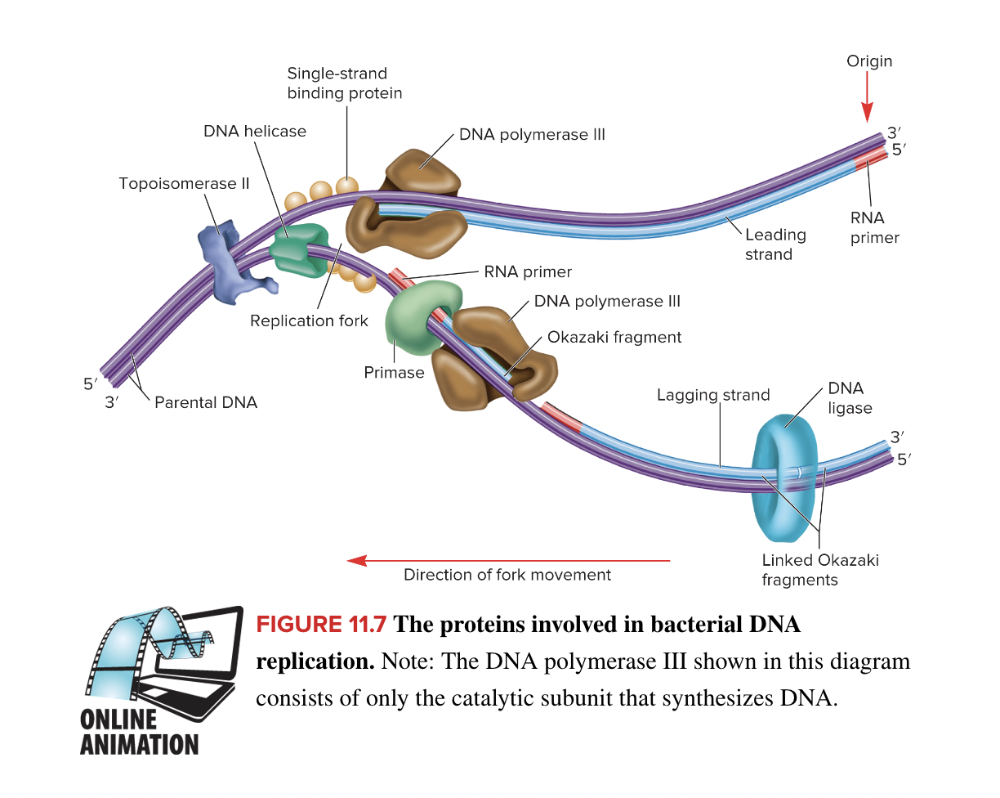
- A DNA polymerase III
- B Single stranded binding protein
- C DNA helicase
- D Topoisomerase II
- E Primase
- F DNA ligase
Select all that apply
Select the three types of DNA sequences located within the oriC complex.
Multiple select question.
Promoter
DnaA box sequence
AT-rich region
Replication fork
GATC methylation site
DnaA box sequence
AT-rich region
GATC methylation site
List the events that occur at oriC to initiate DNA replication, putting the first step at the top.
DNA helicase proteins bind to the origin
HU, IHF and other DNA binding proteins cause the DNA to wrap around the DnaA complex
DNA helicase separates the DNA in both directions creating two replication forks
DnaA protein binds to the DnaA box sequence
The double-stranded DNA molecule separates at the AT-rich region

Answer in the picture.
The role of topoisomerase II (DNA gyrase) in replication is to ______.
Multiple choice question.
synthesize the RNA primer
synthesize new DNA
stabilize the replication fork
break hydrogen bonds between complementary bases
remove positive supercoiling in the DNA
remove positive supercoiling in the DNA
The enzyme that converts a double-stranded DNA region into two single strands by breaking the hydrogen bonds between the strands is called DNA ____.
helicase
Proteins that function to stabilize the replication fork by preventing the reformation of the double strand are called ______.
Multiple choice question.
helicases
GATC methylation sites
single strand binding proteins
DNA polymerases
topoisomerases
single strand binding proteins
During DNA replication, what is the role of the GATC methylation site within the oriC?
Multiple choice question.
Promote termination of replication
Recruit DNA helicase to bind
Regulate DNA replication initiation
Alleviate positive supercoiling
Regulate DNA replication initiation
The enzyme that synthesizes the short molecules of RNA, called RNA primers, is called ____.
primase
Match the following proteins with the function they serve in E. coli DNA replication.
Primase
DNA polymerase III
DNA polymerase I
DNA ligase
Tus
Synthesizes RNA primers
Covalently attaches adjacent Okazaki fragments
Removes RNA primers and fills the gaps with DNA
Binds to ter sequences, preventing the advancement of the replication fork
Synthesizes DNA of both leading and lagging strand
- Primase Synthesizes RNA primers
- DNA polymerase III Synthesizes DNA of both leading and lagging strand
- DNA polymerase I Removes RNA primers and fills the gaps with DNA
- DNA ligase Covalently attaches adjacent Okazaki fragments
- Tus Binds to ter sequences, preventing the advancement of the replication fork
Which newly synthesized DNA molecule has multiple primers?
Multiple choice question.
Lagging strand
Leading strand
Lagging strand
The name of the enzyme that travels in front of helicase to remove positive supercoiling in the DNA is called ____ ____.
DNA gyrase or topoisomerase II
What is the function of DNA polymerase?
Multiple choice question.
Synthesis of RNA primers
Stabilization of the replication fork
Synthesis of DNA on both the leading and lagging strands
Reduction of positive supercoiling in the DNA
Synthesis of DNA on both the leading and lagging strands
Identify the role of single-strand binding proteins.
Multiple choice question.
Stabilize the replication fork by preventing the reformation of the double strand
Break hydrogen bonds between complementary bases
Synthesize the RNA primer
Remove positive supercoiling in the DNA
Synthesize the new DNA molecule
Stabilize the replication fork by preventing the reformation of the double strand
The short molecules of RNA that start the DNA replication process are called ____ ____.
RNA primers
Select all that apply
Identify the three DNA polymerases found in E. coli that play a role in the replication of damaged DNA and DNA repair.
Multiple select question.
DNA polymerase II
DNA polymerase III
DNA polymerase V
DNA polymerase I
DNA polymerase IV
DNA polymerase II
DNA polymerase V
DNA polymerase IV
Which newly synthesized DNA molecule has a single primer?
Multiple choice question.
Lagging strand
Leading strand
Leading strand
Which DNA polymerase involved in E. coli DNA replication consists of 10 subunits?
Multiple choice question.
DNA polymerase IV
DNA polymerase III
DNA polymerase I
DNA polymerase II
DNA polymerase III
List the functions of key proteins involved with bacterial DNA replication
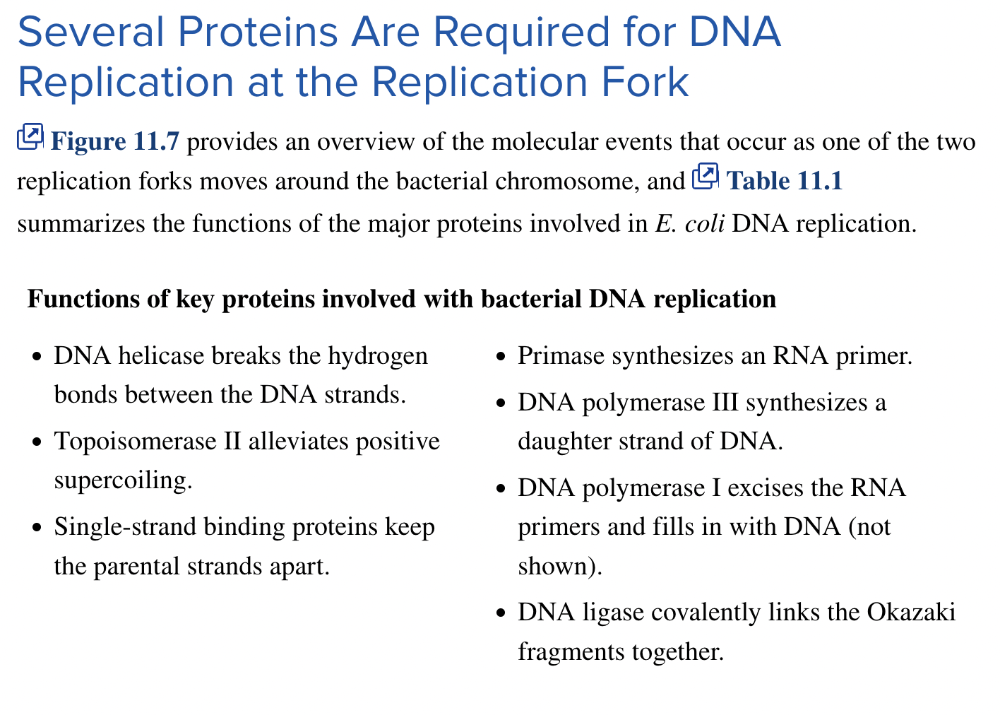
Answer in the picture.
Which enzyme synthesizes the DNA of both the leading and lagging strand?
Multiple choice question.
DNA polymerase
RNA primase
Helicase
DNA gyrase
DNA polymerase
DNA polymerase can only add nucleotides in the ____ to ____ direction.
5' to 3'
Proteins that function to stabilize the replication fork by preventing the reformation of the double strand are called ______.
Multiple choice question.
GATC methylation sites
topoisomerases
DNA polymerases
single strand binding proteins
helicases
single strand binding proteins
During DNA replication, synthesis of the ____ strand is continuous while synthesis of the ____ strand is discontinuous.
leading; lagging
Select all that apply
Identify the two DNA polymerases found in E. coli that play a role in normal DNA replication.
Multiple select question.
DNA polymerase IV
DNA polymerase II
DNA polymerase III
DNA polymerase V
DNA polymerase I
DNA polymerase III
DNA polymerase I
Match the following proteins involved in E. coli DNA replication with the correct function.
DnaA proteins
DnaC proteins
DnaB (helicase)
Topoisomerase II (DNA gyrase)
Single stranded binding proteins
Removes positive supercoiling ahead of the replication forks
Bind to DnaA box proteins within the oriC to initiate DNA replication
Separates double-stranded DNA
Aid DnaA in the recruitment of helicase to the origin
Bind to single-stranded DNA and prevent it from re-forming a double-stranded structure
- DnaA proteins Bind to DnaA box proteins within the oriC to initiate DNA replication
- DnaC proteins Aid DnaA in the recruitment of helicase to the origin
- DnaB (helicase) Separates double-stranded DNA
- Topoisomerase II (DNA gyrase) Removes positive supercoiling ahead of the replication forks
- Single stranded binding proteins Bind to single-stranded DNA and prevent it from re-forming a double-stranded structure
Small segments of DNA synthesized on the lagging strand of DNA are called ___ ___.
Okazaki fragments
DNA polymerase III is a complex of ______ subunit(s) while DNA polymerase I is composed of ______ subunit(s).
Multiple choice question.
5 ; 3
3 ; 1
1 ; 5
10 ; 1
10 ; 3
10 ; 1
DNA polymerase attaches nucleotides to the newly synthesized strand in the ______.
Multiple choice question.
5'-to-3' direction or the 3'-to-5' direction
3'-to-5' direction only
5'-to-3' direction only
5'-to-3' direction only
The enzyme that catalyzes the formation of a covalent phosphodiester bond between adjacent Okazaki fragments is called DNA
ligase
List the events of DNA synthesis at the replication fork in the correct sequence.
DNA strands separate at the origin, creating two replication forks.
DNA polymerase I removes the primers and adds DNA.
DNA ligase catalyzes the phosphodiester bond between adjacent Okazaki fragments.
RNA primers are added to both the leading and lagging strand.
DNA polymerase III adds nucleotides to the 3' end continuously on the leading strand, and discontinuously on the lagging strand.

Answer in the picture.
Select all that apply
Which components are needed to make up the complex called a primosome?
Multiple select question.
DNA polymerase III
primase
topoisomerase II
DNA polymerase I
DNA ligase
DNA helicase
primase
DNA helicase
Small segments of DNA, called Okazaki fragments, are synthesized on the ____ ____.
Lagging strand
What is a replisome?
Multiple choice question.
A primosome physically associated with two DNA polymerase holoenzymes
A complex of two DNA polymerase molecules
A primase complexed with DNA helicase
DNA ligase associated with an Okazaki fragment
A primosome physically associated with two DNA polymerase holoenzymes
Which DNA polymerase involved in E. coli DNA replication consists of 10 subunits?
Multiple choice question.
DNA polymerase III
DNA polymerase IV
DNA polymerase II
DNA polymerase I
DNA polymerase III
In dimeric DNA polymerase, two molecules of DNA polymerase _____ act together to replicate the leading and lagging strands of DNA.
Multiple choice question.
IV
III
I
II
V
III
Which enzyme catalyzes the formation of a covalent bond between adjacent Okazaki fragments?
Multiple choice question.
DNA gyrase
DNA polymerase I
RNA primase
DNA ligase
Helicase
DNA ligase
Identify the protein that binds to the ter sequence to terminate DNA replication.
Multiple choice question.
oriC
DnaA
Tus
DnaB
Tus
A complex consisting of DNA helicase and primase is called a ____.
primosome
Two transiently intertwined molecules of DNA are called a ____.
catenanes
A primosome physically associated with two DNA polymerase holoenzymes is called a ____.
replisome
A temperature-sensitive mutant is an example of a ____ mutant.
conditional
A complex of two DNA polymerase holoenzymes that move as a unit during DNA replication is described as ______ DNA polymerase.
Multiple choice question.
conjoined
duplex
dimeric
paired
dimeric
The energy used to fuel the endergonic reaction of DNA replication is supplied from the exergonic cleavage of ______.
Multiple choice question.
the primosome
adenosine triphosphate (ATP)
DNA polymerase
the replisome
a deoxyribnucleoside triphosphate (dNTP)
a deoxyribnucleoside triphosphate (dNTP)
The area of DNA where Tus binds to stop the movement of the replication fork is called a ____ ____.termin
termination sequence
DNA polymerase III does not dissociate from the DNA template strand after it has catalyzed the joining of two adjacent nucleotides so it is described as a ____ enzyme.
processive
What are catenanes?
Multiple choice question.
Promoter sequences where initiation factors bind
Transiently intertwined DNA molecules formed during DNA replication
Termination sequences that prevent the movement of the replisome

Transiently intertwined DNA molecules formed during DNA replication
Which molecule, when bound to DNA polymerase III forming a holoenzyme, dramatically increases the processivity of the enzyme?
Multiple choice question.
dNTP
DnaB
DnaA
β subunit
β subunit
A mutation that only blocks DNA replication when specific environmental conditions are present is called a ____ mutant.
conditional or ts
For E. coli, the protein that promotes dimerization of two DNA polymerase III proteins at the replication fork is encoded by which gene?
Multiple choice question.
dnaX
dnaG
dnaB
dnaC
dnaE
dnaX
True or false: The formation of covalent bonds between adjacent nucleotides during DNA replication requires energy input.
True false question.TrueFalse
True
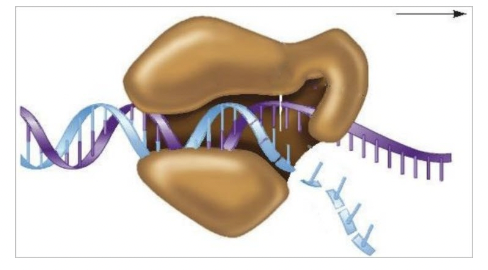
DNA polymerase III is described as a(n) ____ enzyme since, as shown in the diagram, it remains clamped to the DNA template and slides along the template as it catalyzes the synthesis of the daughter strand.
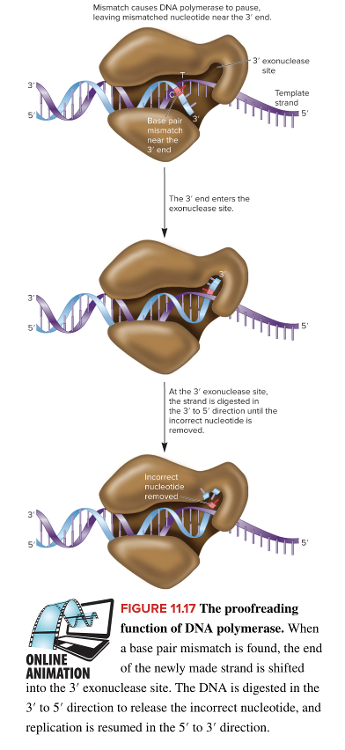
processive
The speed of DNA replication depends on the ability of DNA polymerase III to remain attached to the template strand after catalyzing covalent bonds between adjacent nucleotides. For this reason, it is called a(n) ______ enzyme.
Multiple choice question.
progressive
processive
adhering
binding
catalyzing
processive
Select all that apply
Identify the three mechanisms that ensure the fidelity of DNA replication.
Multiple select question.
DNA polymerase active site structure
DNA proofreading
The ter sequence
Stability of base pairing
Processivity induced by binding of the β clamp
DNA polymerase active site structure
DNA proofreading
Stability of base pairing
In E. coli, the DNA polymerase III holoenzyme, which includes the β subunit, can add nucleotides at a rate of ______ nucleotides per second.
Multiple choice question.
about 750
only 20
about 2,000
more than 10,000
about 750
Select all that apply
Select all of these that are similar in both prokaryotes and eukaryotes.
Multiple select question.
Linear chromosomes
Chromatin compacted within nucleosomes
DNA ligases
DNA helicases
Primases
DNA ligases
DNA helicases
Primases
For E. coli, the protein that recruits DNA helicase to the origin of replication is encoded by which gene?
Multiple choice question.
dnaX
dnaC
dnaB
dnaG
dnaE
dnaC
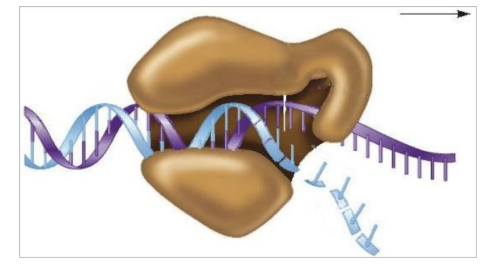
In the diagram, DNA polymerase III surrounds the DNA molecule like a curled hand. This structural arrangement allows DNA synthesis to proceed rapidly due to the ______ of the enzyme.
Multiple choice question.
accuracy
processivity
precision
reactivity

processivity
Which type of cell has chromosomes with multiple origins of replication?
Multiple choice question.
Eukaryote
Prokaryote
Eukaryote
The three mechanisms that ensure the fidelity of DNA replication are the stability of ____ ____, the active site structure of DNA ____ and the process of DNA ____.
Stability of base pairing
DNA polymerase active site
structure
DNA proofreading
In eukaryotes, DNA replication occurs ______ from multiple origins of replication.
Multiple choice question.
unidirectionally
bidirectionally
bidirectionally
Which molecule, when bound to DNA polymerase III forming a holoenzyme, dramatically increases the processivity of the enzyme?
Multiple choice question.
dNTP
β subunit
DnaA
DnaB
β subunit
Autonomously replicating sequences (ARS) are required to initiate DNA replication in ______.
Multiple choice question.
prokaryotes
eukaryotes
eukaryotes
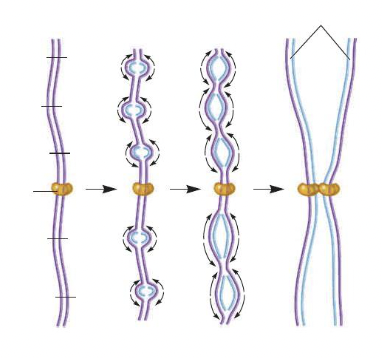
Replication of the chromosome in the diagram is representative of that in a(n) ______.
Multiple choice question.
eukaryote.
prokaryote.
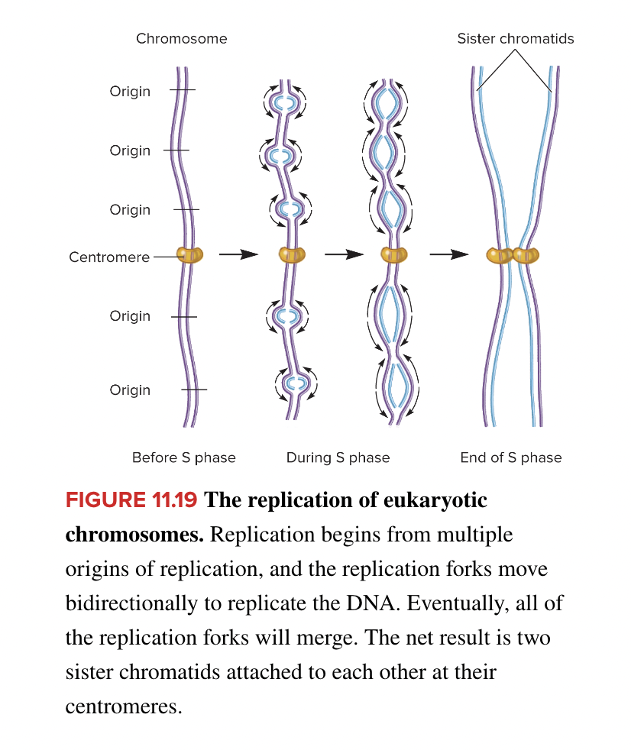
eukaryote
In eukaryotes, DNA replication begins with the ______.
Multiple choice question.
binding of MCM gyrase
assembly of a preRC
binding of MCM helicase
binding of DnaA
assembly of a preRC
True or false: Both prokaryotes and eukaryotes have multiple origins of replication.
True false question.TrueFalse
False
Reason:
Prokaryotes have a single origin of
replication, while eukaryotes have multiple origins of replication.
DNA replication licensing allows DNA synthesis to begin after which protein binds to the origin of replication?
Multiple choice question.
primase
DNA polymerase α
DNA gyrase
MCM helicase
origin recognition complex (ORC)
MCM helicase
True or false: DNA replication in eukaryotes occurs unidirectionally from multiple origins of replication.
True false question.TrueFalse
False
In eukaryotes DNA polymerase ε synthesizes DNA on the ____ strand and DNA polymerase δ synthesizes DNA on the ____ strand.
leading; lagging
What consensus sequence is found in ARS elements?
Multiple choice question.
ATTATTATTATTATTATT
GCGCGCGCGCGCGC
ATTTAT (A or G) TTTA
AGCAGCAG (C or A) AA
ATTTAT (A or G) TTTA
A polymerase switch occurs when the complex of primase with DNA polymerase _____ is exchanged for DNA polymerase ______ on the leading strand and DNA polymerase ______ on the lagging strand.
Multiple choice question.
α; ε; δ
ε; α; δ
ε; δ; α
α; δ; ε
δ; ε; α
α; ε; δ
List the steps of eukaryotic DNA replication initiation in the correct sequence.
MCM helicases bind to the origin of replication
ORC binds to the origin of replication
DNA synthesis begins
- ORC binds to the origin of replication.
- MCM helicases bind to the origin of replication.
- DNA synthesis begins.
What is the function of the complex of primase and DNA polymerase α?
Multiple choice question.
Unwind the DNA at the replication fork
Synthesize a short RNA-DNA primer
Synthesize DNA using the lagging strand as a template
Relax supercoils that form ahead of the replication fork
Synthesize DNA using the leading strand as a template
Synthesize a short RNA-DNA primer
A type of DNA polymerase that is attracted to damaged DNA and can synthsize a complementary strand over the abnormal region is called a - polymerase.
translesion replicating
In a process known as DNA replication ____, the binding of MCM helicase allows DNA replication to begin at an origin of replication in eukaryotic cells.
licensing
True or false: In both eukaryotes and prokaryotes RNA primers are removed by DNA polymerase I.
False
In eukaryotes, RNA primers are removed by flap endonuclease.
Match each eukaryotic DNA polymerase with the correct function.
α
ε
δ
γ
Replication of the leading strand
Initiate DNA replication
Replication of mitochondrial DNA
Replication of the lagging strand
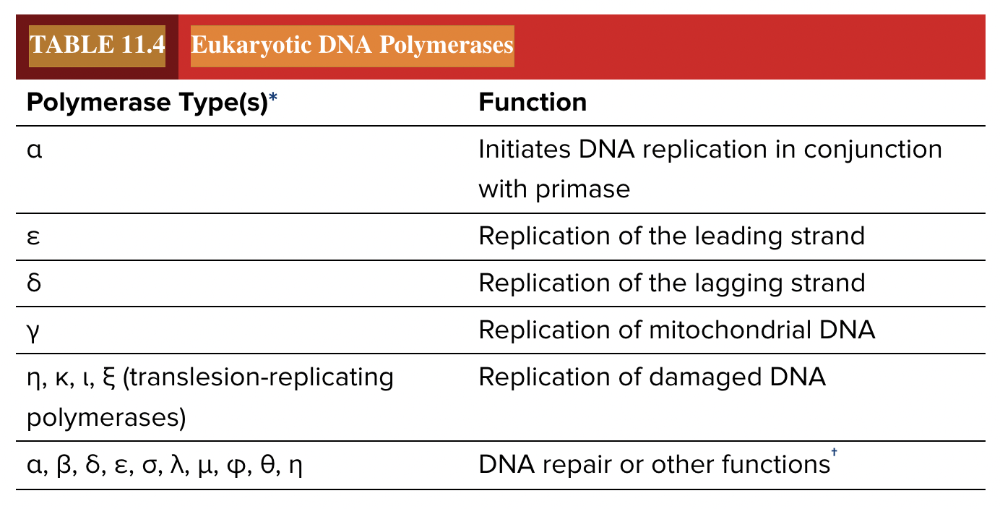
- α Initiate DNA replication
- ε Replication of the leading strand
- δ Replication of the lagging strand
- γ Replication of mitochondrial DNA
The tandemly repeated DNA sequences located at the both ends of eukaryotic chromosomes, as shown in the image, comprise the ______.
Multiple choice question.
nucleosome
kinetochore
centromere
telomere
telomere
A ____ ____ is the exchange that occurs when a DNA polymerase α/primase complex dissociates from the replication fork and is replaced by DNA polymerase ε or δ.
polymerase switch
DNA polymerase cannot replicate the 3' end of a DNA strand because a ____ cannot be made upstream from this point.
primer
Select all that apply
A complex that synthesizes a short RNA-DNA complex used as a primer in eukaryotic DNA replication is made from which components?
Multiple select question.
DNA polymerase α
DNA polymerase ε
DNA polymerase δ
helicase
primase
DNA gyrase
DNA polymerase α
primase
The enzyme that synthesizes the short repetitive sequences at the ends of eukaryotic chromosomes is called ____.
telomerase
An enzyme that can replicate DNA in a damaged region is ______.
Multiple choice question.
DNA polymerase ε
a template repair enzyme
DNA polymerase α
a translesion-replicating polymerase
DNA polymerase δ
a translesion-replicating polymerase
During telomere synthesis the enzyme ____ binds to the 3' overhang region and synthesizes many 6-____ repeats.
telomerase; nucleotide
In eukaryotes, the enzyme ______ removes the RNA primers.
Multiple choice question.
DNA gyrase
MCM helicase
DNA polymerase I
DNA ligase
flap endonuclease
flap endonuclease
Select all that apply
The enzyme telomerase consists of which of the following?
Multiple select question.
RNA
Fatty acids
DNA
Protein subunit
ATP
RNA
Protein subunit
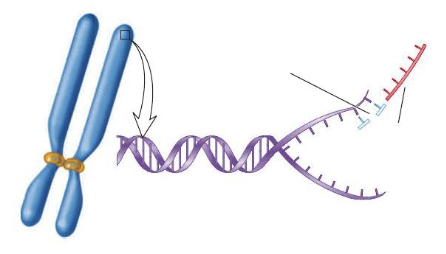
The name for the end of a linear, eukaryotic chromosome is the ____.
telomere
The component of telomerase that enables the enzyme to bind to the telomeric repeat sequence is composed of _____.
Multiple choice question.
DNA
RNA
protein
RNA
Select all that apply
Which characteristics of DNA polymerase prevent the enzyme from replicating the 3' ends of DNA strands?
Multiple select question.
DNA polymerase can only elongate an existing nucleotide strand.
DNA polymerase wraps around the DNA template like a curled hand.
DNA polymerase synthesizes DNA only in a 3' to 5' direction.
DNA polymerase can only catalyze the formation of phosphodiester bonds between nucleotides.
DNA polymerase synthesizes DNA only in a 5' to 3' direction.
DNA polymerase can only elongate an existing nucleotide strand.
DNA polymerase synthesizes DNA only in a 5' to 3' direction.
Telomerase reverse transcriptase is an enzyme that uses a(n) _____ template to produce a(n) ______ strand.
Multiple choice question.
RNA; DNA
RNA; RNA
DNA; RNA
DNA; DNA
RNA; DNA
What is the role of telomerase?
Multiple choice question.
Remove RNA primer flaps created by RNA polymerase I
Prevent the ends of eukaryotic chromosomes from extending
Prevent DNA replication of the centromere region
Prevent the ends of eukaryotic chromosomes from shortening
Prevent the ends of eukaryotic chromosomes from shortening
List the events of telomere synthesis in the correct sequence, putting the first event on top.
Telomerase binds to the 3' overhang region
Telomerase synthesizes a 6-nucleotide repeat
Telomerase shifts and synthesizes many more 6-nucleotide repeats
The complementary strand is made by primase, DNA polymerase, and ligase
1) telomerase binds to the 3' overhang region
2) telomerase
synthesizes a 6-nucleotide repeat
3) telomerase shifts and
synthesizes many more 6-nucleotide repeats
4) the complementary
strand is made by primase, DNA polymerase, and ligase
The enzyme telomerase consists of protein subunits and ____, which is complementary to the DNA sequence in the telomeric repeat.
RNA
True or false: Telomeres remain the same length throughout the lifespan of a cell.
False
Telomerase RNA component ______.
Multiple choice question.
polymerizes DNA to lengthen the telomeres
synthesizes a strand of DNA that is complementary to the lengthened telomeric strand
contains a sequence complementary to the telomeric repeat sequence
contains a sequence complementary to the telomeric repeat sequence
As telomeres of a somatic cell shorten, the cell may become ______, losing the ability to divide.
Multiple choice question.
mature
senescent
unresponsive
quiescent
senescent
The subunits of the enzyme telomerase that are responsible for lengthening the ends of the chromosomes are called telomerase ____ ____.
reverse transcriptase
The ability of cancer cells to continue to divide indefinitely is due to an increase in the activity of the enzyme ______.
Multiple choice question.
DNA ligase
telomerase
DNA gyrase
DNA polymerase α
telomerase
The enzyme that synthesizes the short repetitive sequences at the ends of eukaryotic chromosomes is called ____.
telomerase
In actively dividing cells, telomeres tend to ______ with age.
Multiple choice question.
remain the same
shorten
lengthen
shorten
In somatic cells, telomeres tend to shorten with age. When telomeres are too short, the cells become ____, meaning that they lose their ability to ____.
senescent; divide, duplicate, or reproduce
Many types of cancer cells have an increase in the activity of ______.
Multiple choice question.
telomerase
DNA gyrase
MCM helicase
DNA polymerase α
telomerase
